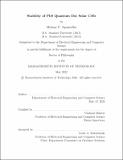The Stability of PbS Quantum Dot Solar Cells
Author(s)
Sponseller, Melany C.
DownloadThesis PDF (78.00Mb)
Advisor
Bulović, Vladimir
Terms of use
Metadata
Show full item recordAbstract
Solution-based lead sulfide (PbS) quantum dots (QDs) may enable lightweight solar cells that facilitate high-throughput module manufacturing, simplify module installation, and bring light-harvesting functionality to unconventional or weight-restricted surfaces. Proven long-term stability is critical for QD solar cells to reach commercial viability, since solar cells deployed in the field must typically operate for years with minimal loss in efficiency. However, the operational stability and associated aging processes of QD solar cells are not fully understood. Existing measurements of QD solar cell lifetimes are often conducted under non-standardized stress conditions and primarily highlight relative improvements over baseline devices rather than underlying causes of performance degradation.
In this work, we systematically investigate aging processes that lead to QD solar cell performance evolution during short-term shelf storage and long-term continuous operation. First, we analyze the role of short-term air exposure in improving the initial efficiency of PbS QD solar cells. We show that brief air exposure treatments elicit multiple oxidation processes that benefit PbS QD solar cell performance in the near-term. In particular, post-fabrication air exposure is necessary to heal the QD-top electrode interface following thermal evaporation of electrodes onto QDs.
Next, we characterize the operational stability of PbS QD solar cells under systematically tuned stress conditions such as continuous illumination, heating, environment, and electrical bias. We demonstrate conventional QD solar cells are capable of operating lifetimes approaching 1000 hours or longer if actively cooled, but photothermal instabilities likely limit their current utility for applications requiring sustained operation above room temperature. We also provide evidence of electrode migration-induced degradation in hole transport layer-free QD solar cells, highlighting the need to consider diffusion barrier properties when evaluating next-generation hole transport materials.
Date issued
2022-05Department
Massachusetts Institute of Technology. Department of Electrical Engineering and Computer SciencePublisher
Massachusetts Institute of Technology